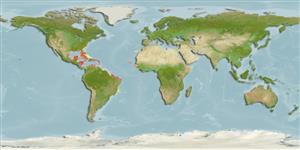Neopetrosia rosariensis (Zea & Rützler, 1983)
| Native range | All suitable habitat | Point map | Year 2050 |

|
| This map was computer-generated and has not yet been reviewed. |
| Neopetrosia rosariensis AquaMaps Data sources: GBIF OBIS |
Upload your photos
Google image |
No photo available for this species.No drawings available for Petrosiidae.
Google image |
No photo available for this species.
Classification / Names Common names | Synonyms | CoL | ITIS | WoRMS
Demospongiae | Haplosclerida | Petrosiidae
Environment: milieu / climate zone / depth range / distribution range Ecology
Sessile; depth range 2 - 30 m (Ref. 415). Tropical
Distribution Countries | FAO areas | Ecosystems | Occurrences | Introductions
Atlantic Ocean: Panama, Canary Islands and Colombia.
Length at first maturity / Size / Weight / Age
Maturity: Lm ? range ? - ? cm Max length : 78.0 cm H male/unsexed; (Ref. 415)
Short description Morphology
Cylindrical tubes: 4 - 78 cm high, 2 - 13 cm wide; emerge from basal mass. Dark reddish-brown externally, tan internally. Hard and dense. Smooth to the touch, with rugose and uneven parts, Sometimes covered by zooanthids. Oscules on the inner wall of tubes; 0.06 - 0.34 cm wide (Ref. 415).
Life cycle and mating behavior Maturity | Reproduction | Spawning | Eggs | Fecundity | Larvae
Members of the class Demospongiae are hermaphroditic. Life cycle: The zygote develops into parenchymella larva (free-swimming) before settling down on a substrate where it grows into a young sponge.
Main reference
References | Coordinator | Collaborators
Collin, R., M.C. Díaz, J. Norenburg, R.M. Rocha, J.A. Sánchez, M. Schulze, A. Schwartz and A. Valdés. 2005. (Ref. 415)
IUCN Red List Status (Ref. 130435: Version 2024-1)
CITES status (Ref. 108899)
Not Evaluated
CMS (Ref. 116361)
Not Evaluated
Threat to humans
Harmless
Human uses
| FishSource |
Tools
More information
Trophic Ecology
Food items
Diet
Food consumption
Ration
Predators
Diet
Food consumption
Ration
Predators
Ecology
Population dynamics
Growth
Age/Size
Length-weight
Length-length
Length-frequencies
Mass conversion
Recruitment
Abundance
Age/Size
Length-weight
Length-length
Length-frequencies
Mass conversion
Recruitment
Abundance
Life cycle
Distribution
Human Related
Aquaculture profile
Stamps, Coins Misc.
Stamps, Coins Misc.
Outreach
Taxonomy
References
Internet sources
BHL | BOLD Systems | CISTI | DiscoverLife | FAO(Publication : search) | Fishipedia | GenBank (genome, nucleotide) | GloBI | Gomexsi | Google Books | Google Scholar | Google | PubMed | Tree of Life | Wikipedia (Go, Search) | Zoological Record
Estimates based on models
Preferred temperature
(Ref. 115969): 23.7 - 28.3, mean 26.9 (based on 185 cells).
Price category
(Ref. 80766):
Unknown.


